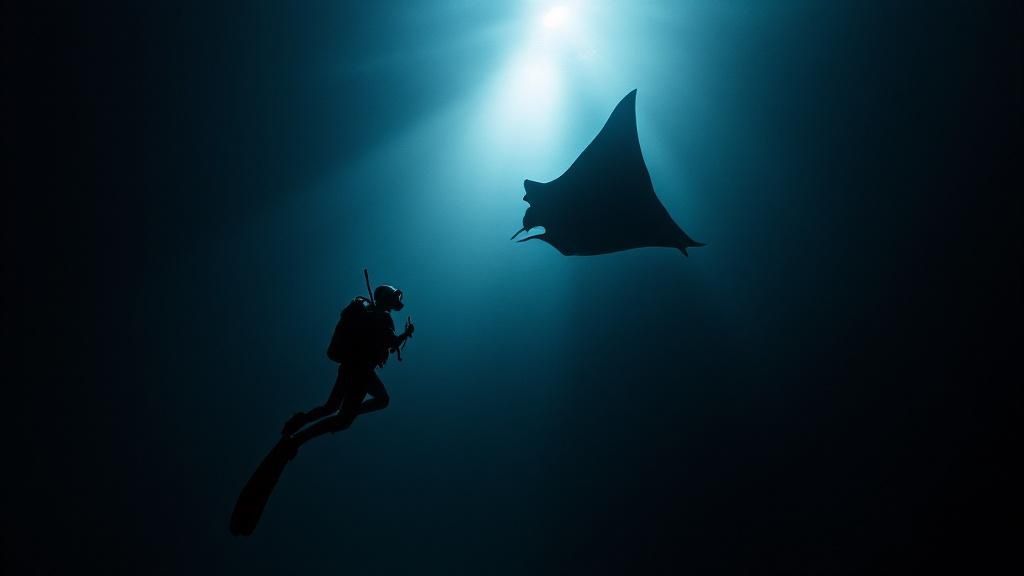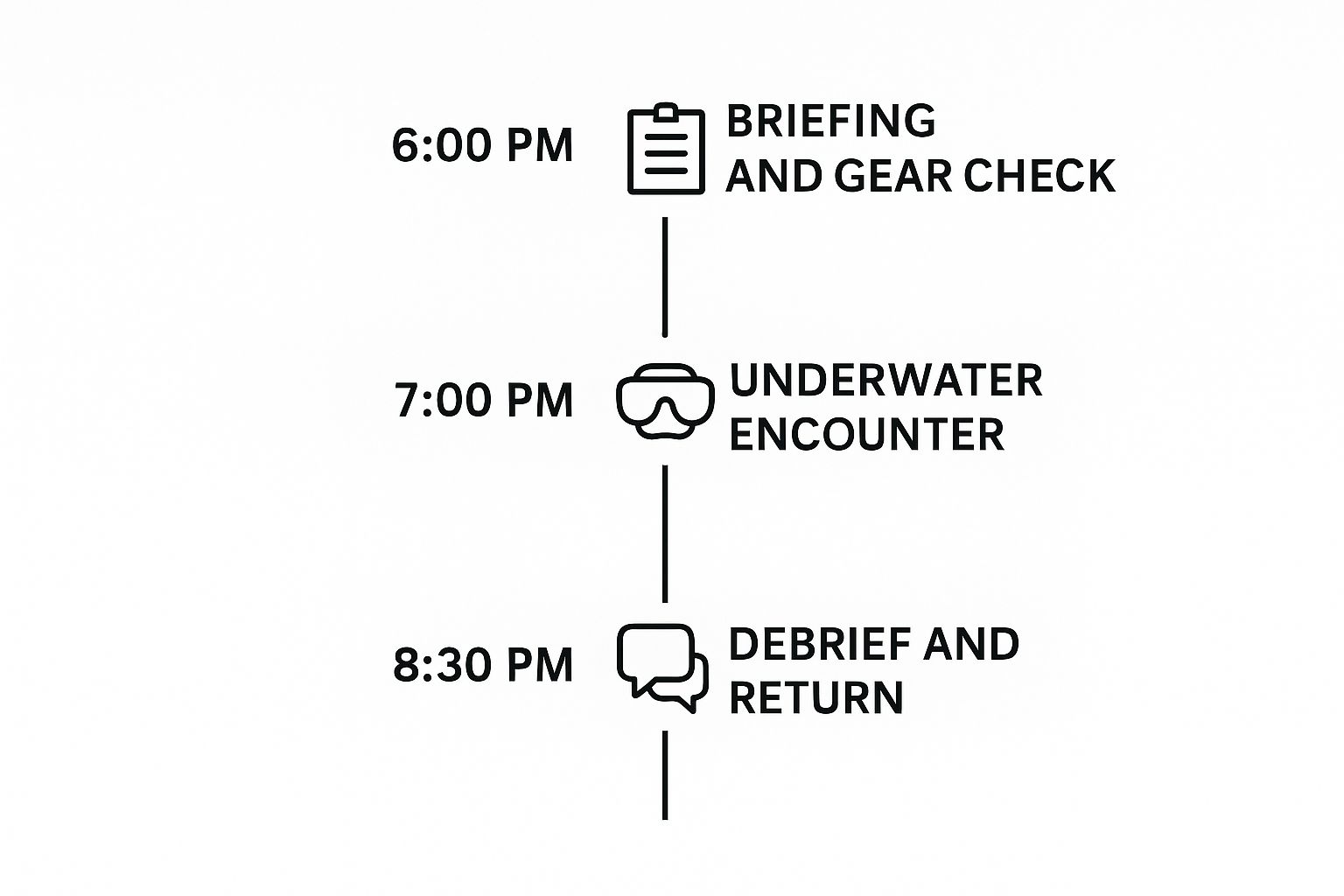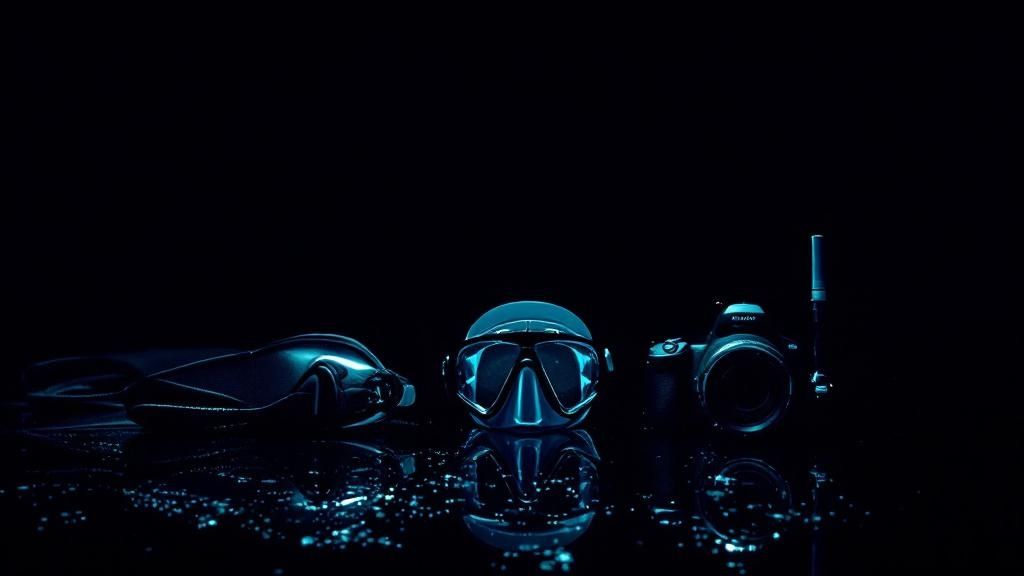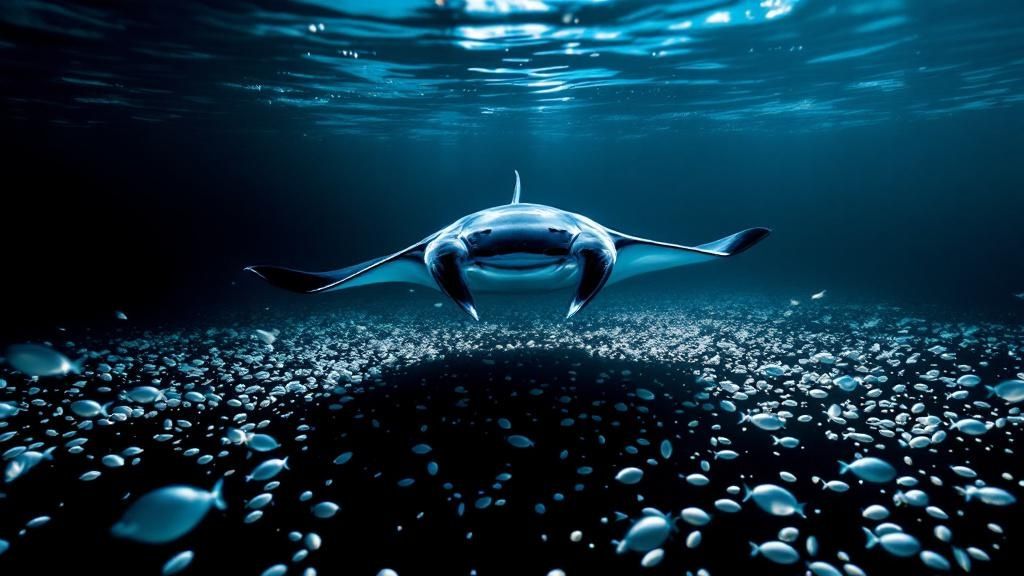Why Kona Creates The World's Best Manta Ray Encounters
Picture this: you're floating in the warm, dark Pacific waters just after sunset. Suddenly, a squadron of majestic, 12-foot manta rays glides into view, performing an underwater ballet just inches from your face. This isn't a rare stroke of luck; it's a nightly spectacle made possible by Kona's unique ocean conditions, creating one of the planet's most reliable and awe-inspiring wildlife encounters.
The experience is so consistent that it draws an estimated 80,000 people each year. Tour operators report sighting success rates between 80% and 90% year-round, cementing its reputation as a world-class destination. You can learn more about Hawaii's incredible manta tourism phenomenon and what makes it so special in this detailed article on news.outrigger.com.
The Perfect Plankton Storm
The secret to this incredible gathering lies beneath the waves, in the Big Island's volcanic geology. The steep underwater slopes along the Kona coast act as a natural funnel, creating the perfect underwater pantry for manta rays.
Think of it like this: deep, nutrient-rich ocean currents flow towards the island and are forced upward when they meet the sharp volcanic inclines. This upwelling, combined with plenty of sunlight, sparks massive blooms of plankton—the microscopic organisms that manta rays feast on. This reliable, nightly buffet is what sets Kona apart. While many other global manta hotspots are primarily "cleaning stations," Kona offers front-row seats to a spectacular feeding frenzy.
The mantas have learned that specific coves and bays along this coast are natural collection points for their favorite food, leading them to gather predictably every evening. This dependable food source is the reason a large, non-migratory population of reef mantas has made Kona their permanent home.
The chart below shows just how reliable these encounters are at Kona's two primary sites.

As the data illustrates, both "Manta Village" and "Manta Heaven" consistently attract multiple rays almost every single night, which is the foundation of Kona's worldwide fame for this experience.
Kona's Premier Manta Hotspots
This natural phenomenon is concentrated in a few key locations along the coast. To help you choose the right spot, here is a comparison of Kona's top manta ray dive sites.
| Site Name | Max Depth | Experience Level | Average Mantas Seen | Best Time |
|---|---|---|---|---|
| Manta Village (Kaukalaelae Point) | 35 ft (11 m) | Beginner (Snorkel/Dive) | 5-15 | Year-round, slightly more consistent |
| Manta Heaven (Garden Eel Cove) | 40 ft (12 m) | Beginner (Snorkel/Dive) | 3-10 | Year-round, can have epic nights |
| "The Point" (Advanced Site) | 60-70 ft (18-21 m) | Advanced (Dive Only) | Varies, sometimes 20+ | Conditions permitting |
These locations, particularly Manta Village and Manta Heaven, have become legendary in the diving community. They aren't just random spots; they are specific underwater amphitheaters where the topography and currents work in perfect harmony to concentrate plankton.
Over decades, this has conditioned the local manta population to return like clockwork. This consistency not only makes the manta ray dive kona a bucket-list adventure but also a crucial site for scientific research, giving experts a predictable environment to study the behavior of these gentle giants.
What Really Happens During a Manta Ray Night Dive
The excitement for a Kona manta ray night dive starts the second you step on the boat, but the real magic unfolds like a perfectly staged underwater show. This isn't just about jumping in the water; it's a carefully managed event designed for safety and to give you the best possible view. You're not just a spectator—you're a crucial part of the performance.
Here’s a look at what a typical manta ray excursion involves from start to finish.
| Time | Activity | Duration | What to Expect |
|---|---|---|---|
| 5:00 PM | Check-in & Gear Up | 30 mins | Arrive at the harbor, meet the crew, sign waivers, and get fitted for your wetsuit, mask, and fins. |
| 5:30 PM | Boat Departure & Briefing | 30 mins | The boat heads out as the sun begins to set. The crew gives a detailed safety and environmental briefing. |
| 6:00 PM | Arrive at Dive Site | 15 mins | The boat anchors at the manta site. The crew begins setting up the lights and floating raft. |
| 6:15 PM | Enter the Water | 45-60 mins | Divers descend to the "campfire" on the seafloor. Snorkelers hold onto the surface raft. The lights go on. |
| 7:00 PM | Exit Water & Debrief | 30 mins | Back on the boat, everyone warms up with hot chocolate or soup while sharing stories of the encounter. |
| 7:30 PM | Return to Harbor | 30 mins | Enjoy the ride back under the stars, filled with the fresh memory of the manta ballet. |
This timeline shows how every part of the trip is planned, with the main underwater event lasting about an hour. This core experience is surrounded by important briefings to prepare you and a warm debrief to cap off the night.
The Underwater Stage Is Set
Once you get to the dive location—often called "Manta Village" or "Manta Heaven"—the crew prepares the main attraction. If you're diving, you'll descend to a sandy patch on the ocean floor, usually around 35-40 feet deep. You and the other divers will form a semi-circle, creating an "arena" for the mantas. Snorkelers stay on the surface, holding onto a specially designed floating raft.
Light is the secret ingredient for this entire encounter. Powerful lights are positioned in the middle of the group, aimed straight up. This light attracts a thick swarm of plankton, which is the mantas' favorite meal. Think of it like turning on a porch light on a summer evening and watching the moths gather. Your light source creates a glowing, all-you-can-eat buffet that draws the gentle giants right to you. If you're curious about the science, you can explore our guide on what a manta ray night dive is for more on the setup.
This image shows the unique positioning and lighting that researchers and guides use to create the experience.

This arrangement isn't a happy accident; it’s a method that has been refined over many years to create reliable encounters while ensuring everyone, including the mantas, stays safe.
The Main Event: The Manta Ballet
The first time you see a manta ray appear out of the dark water is a moment that will genuinely take your breath away. They don’t just swim; they glide, soar, and perform barrel rolls through the beams of light, scooping up plankton with their huge mouths. Their movements are completely silent and graceful, a beautiful contrast to the sound of your own breathing underwater.
You'll likely see a few key behaviors:
- The Swoop: Mantas glide directly over your head, sometimes getting within inches of your mask before effortlessly pulling away at the last second.
- The Barrel Roll: They execute elegant, looping somersaults inside the cone of light, which helps them feed as efficiently as possible.
- The Train: Occasionally, several mantas will line up and follow each other, creating a stunning procession through the water.
The experience is a full-on sensory delight. The quiet majesty of their flight, the incredible size of their wingspans (often 12 feet or more), and their seemingly intelligent eyes create a powerful connection that’s hard to put into words. It’s a humbling encounter that reminds you of the ocean's grandeur and is precisely why this dive is consistently named one of the best wildlife experiences in the world.
Essential Safety Prep That Could Save Your Life
A manta ray dive in Kona isn't just any scuba dive; it's a specialized underwater event that requires more than your standard Open Water certification. You can think of it like preparing for an underwater performance where you have a very specific, and important, role to play. The combination of darkness, massive marine animals, and a unique setup means you need certain skills to keep the dive magical and, above all, safe for everyone involved.
Your preparation starts long before you step onto the boat. It’s about being mentally ready and having a firm grasp of the unique rules for this specific dive. These aren't just helpful hints; they are strict protocols, fine-tuned over thousands of dives to protect both the divers and the precious resident manta ray population.
Skills Beyond Basic Certification
While your Open Water certification is the essential starting point, a manta ray night dive presents challenges that demand a higher level of skill. The biggest hurdle is operating in near-complete darkness, with only dive lights cutting through the black. This is where having specific night diving training really pays off.
This screenshot from a PADI course gives you an idea of the core skills involved, like managing your light and finding your way around in the dark.

As you can see, a night diving certification is all about building your confidence and ability in low-light conditions—skills that transfer directly to the Kona manta dive. With this training under your belt, you'll feel much more at ease handling your gear, controlling your buoyancy, and communicating when you can't rely on daylight.
The Rules of Engagement
Your dive guide will walk you through a set of critical rules during the pre-dive briefing. These are non-negotiable. Following them is your most important job once you're in the water.
- Observe, Don’t Touch: This is the absolute golden rule. Touching a manta ray can strip away its protective mucous coating, making it susceptible to dangerous infections. Let them come to you, but never, ever reach out.
- Stay on the Bottom: All divers are required to stay put on the sandy seabed. This creates a safe "stage" for the mantas to glide and feed above. Floating up into their flight path is a serious risk to both you and the animals.
- Light Discipline: Your dive light serves one purpose: to attract plankton. It's not a spotlight for you to shine directly into a manta's eyes. You must always point your light beam straight up toward the surface, creating a glowing column of "food" that draws them in.
- Control Your Bubbles: As a manta passes directly overhead, try to time your breathing to avoid exhaling a blast of bubbles right into its path. A sudden burst can startle them, interrupting their feeding and causing them to leave the area.
Picture yourself as a silent, respectful audience member at a truly exclusive natural spectacle. By following these straightforward but vital rules, you help ensure a safe, sustainable, and utterly breathtaking experience that protects these gentle giants for many more divers to enjoy in the future.
Choosing Your Perfect Manta Ray Experience
Not every manta ray dive kona tour offers the same kind of magic. Picking the right one is like selecting the perfect seat for a once-in-a-lifetime show—your choice directly shapes what you see and feel. The biggest decision you'll make is whether to snorkel or scuba dive, as each provides a completely different angle on the underwater ballet.
To Snorkel or to Dive?
The choice between snorkeling and diving comes down to your personal comfort in the water and what you hope to get out of the experience. There’s no right or wrong answer; each has its unique appeal.
- Snorkeling: You'll hold onto a specially designed floatboard on the ocean's surface. Bright lights attached to the board shine down into the water, acting like a magnet for plankton. This, in turn, draws the mantas right up to you. It's a fantastic option for families, those who aren't certified divers, or anyone who wants a gear-light way to witness the spectacle. You get a stunning top-down view of the feeding frenzy below.
- Scuba Diving: For certified divers, this is the ultimate immersive option. You’ll descend to the sandy seafloor, around 30-40 feet deep, and watch from below. The mantas glide gracefully just inches above you, their enormous wingspans silhouetted against the dark surface. It's a humbling and truly awe-inspiring perspective.
While the Kona Manta Ray Night Dive is a singular adventure, exploring different types of scuba diving experiences across the globe can open up a whole new world of underwater exploration.
How to Choose a Great Operator
With so many companies offering tours, it's important to look past the flashy websites and find a truly reputable operator. This choice affects your safety, your enjoyment, and the well-being of the gentle giants you’re there to see. Conservation efforts are a huge part of the Kona manta story. Since 2009, dedicated researchers and tour operators have been tracking individual rays by their unique belly spot patterns. As of 2024, this incredible citizen science project has identified over 290 individual reef mantas along the Kona coast, gathering priceless information on their population and health. You can find more details on this important manta ray research to see how your tour can contribute.
When you're researching companies, pay close attention to reviews.
This image highlights just how many options are out there. To narrow it down, focus on operators with consistently high ratings and specific comments about safety protocols and small group sizes. A smaller group typically leads to a more intimate and less crowded encounter. A top-tier operator always puts manta-safe practices first, ensuring the experience is sustainable and unforgettable for all the right reasons.
Protecting Mantas While Creating Memories
The amazing consistency of the manta ray dive kona experience depends on a delicate balance between people and nature. When you join this nightly event, you're not just a tourist; you are a guest in a fragile underwater ecosystem. Your actions, no matter how small, have a direct impact on the well-being and behavior of these gentle giants, helping to ensure this incredible encounter continues for years to come.

Groups like Manta Ray Advocates demonstrate how deeply the Kona community is committed to protecting its resident manta population through education and clear guidelines. This commitment shows why it's so important to book with operators who follow these standards. When you do, your money helps support a sustainable future for the rays.
The Dos and Don'ts of Manta Etiquette
Imagine you are visiting a world-renowned museum—your respect and behavior are key. To keep the mantas safe, a strict and globally recognized set of rules has been developed. Following these isn't just a friendly suggestion; it's a requirement for a safe and ethical interaction.
- Observe, Never Touch: This is the single most important rule. Manta rays have a protective mucous coating that works like our immune system. Touching them can strip away this layer, making them susceptible to painful and sometimes fatal skin infections. Let the mantas decide how close they get.
- Stay in Your Zone: Divers should remain still on the sandy ocean floor. Snorkelers must stay on the surface, holding onto their light float. This method creates an open and clear "stage" for the mantas to feed. Drifting into their path is dangerous for everyone involved.
- Lights Up (or Down): Your flashlight's job is to attract plankton, not to shine on a manta. If you're diving, point your light straight up to the surface. If you're snorkeling, the lights on your float will shine straight down. Never shine your light directly into a manta's eyes, as this can disorient them and cause stress.
- Mind Your Bubbles: If a manta ray glides directly over your head, try to manage your breathing. A sudden, forceful release of bubbles can startle them, interrupting their feeding and causing them to swim away.
Your Dive Can Make a Difference
By choosing to participate in a responsible manta ray dive in Kona, you become an active part of the conservation effort. A portion of tour fees often goes to local research and advocacy groups dedicated to protecting these animals and their marine home. It’s a powerful demonstration of how eco-tourism, when managed correctly, can directly fund the preservation of the creatures that make the experience so special.
If you want to dive deeper into what makes this encounter so profound, check out our article on why you should go on a manta ray dive in Kona. By being a thoughtful guest in their world, you help guarantee the manta ray ballet will continue to inspire for generations.
Insider Secrets for Unforgettable Manta Encounters
While a manta ray dive in Kona already has a very high success rate, a few insider tips can turn a great dive into a mind-blowing one. It's a bit like a seasoned wildlife photographer knowing exactly where to stand for the perfect shot. For divers, it all starts with understanding your place in the underwater theater.
Optimal Positioning and Manta Body Language
Veteran guides will tell you the best spots aren't always right in the middle of the action. Instead of planting yourself directly under the main lights—the "campfire," as it's often called—try setting up slightly off to the side. This spot is often less crowded and gives you a fantastic view of the mantas as they emerge from the darkness into the light.
From this vantage point, you can also get a better read on their body language. A relaxed manta glides with smooth, graceful wing beats. If they start to feel crowded or disturbed by too many bubbles, their movements might become jerky, or they might just leave the scene. By staying calm and still, you become a non-threatening part of their world, which often encourages them to glide closer.
Advanced Strategies for Better Encounters
It's not just about where you sit. A few other simple adjustments can make a huge difference in your manta encounters.
- Follow the Plankton: Keep an eye on where the plankton gathers in the water. Mantas are there for the buffet, so they'll follow their food. Small shifts in the current can alter their flight paths during the dive.
- Time Your Bubbles: Obviously, you can't hold your breath, but you can be mindful of your exhalations. Try to avoid letting out a big cloud of bubbles right when a manta is passing overhead, as the sudden rush can startle them.
- Embrace Stillness: The less you move, the better your chances for a close encounter. Mantas are curious creatures, but also cautious. When you remain still on the seafloor, you're signaling that you're not a predator. This patience is often rewarded with mantas performing their incredible barrel rolls just inches above you.
Capturing the Moment Without Disturbing It
Taking photos on a night dive is a real challenge, but the payoff is immense. Your technique is key to getting great shots without bothering the mantas.
This image shows a diver ready to capture the magic, emphasizing the need for the right gear and positioning. The secret is to work with the ambient light provided by the dive site's setup. Avoid using a powerful, direct flash, as it can easily disorient the mantas. Instead, focus on capturing their dark silhouettes against the bright, plankton-filled water above for truly awe-inspiring photographs. By using these quiet methods, you'll not only bring home amazing images but also help ensure the encounter remains peaceful and respectful for everyone.
Your Complete Manta Ray Adventure Planning Guide
Turning your dream of a manta ray dive in Kona into reality is a bit like planning a perfect outdoor wedding. You can’t just show up and expect everything to fall into place. Success hinges on smart timing, good preparation, and knowing how to work with Hawaii's famously fickle weather. A well-thought-out plan is the difference between an incredible memory and a cancelled tour.
Timing and Weather: The Deciding Factors
While you can spot manta rays in Kona’s waters all year, the prime time to go is from April to October. During these months, the ocean is generally calmer and the water is clearer, offering fantastic conditions for both divers and snorkelers. The winter, particularly from January through March, often brings stronger winds and rougher seas, which can lead to tour cancellations.
This weather-dependent reality means it’s a smart move to book your manta ray adventure early in your vacation. If bad weather forces a cancellation, you have a built-in buffer to reschedule. Many operators provide a "manta guarantee," offering a free or discounted second trip if you don't see any mantas, so having that scheduling flexibility is essential.
Essential Logistics and Preparation
Beyond simply choosing a date, there are a few practical details to handle. First, check the certification requirements. Most dive companies will ask for at least an Open Water certification. It's also wise to ask what gear is included with your tour, though you can always rent. A 3mm wetsuit is usually warm enough, but you might appreciate a thicker 5mm suit during the cooler winter months.
It's also important to prepare your body and mind. If you're susceptible to seasickness, taking medication before you head out is a good idea. Mentally, it's about setting the right expectations and being ready for a genuinely wild encounter that happens on nature's terms, not ours. To get a better sense of what the trip involves, you can explore the manta ray night dive of Kona with Kona Honu Divers to see how a professional tour is run.
Ready to plan your own unforgettable underwater adventure? At Kona Honu Divers, we combine expert guidance with a passion for the ocean to create the ultimate manta ray experience. Book your dive with us today!
